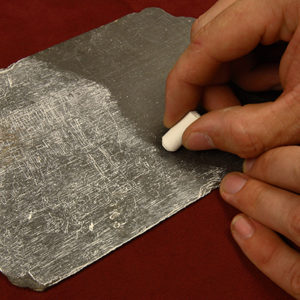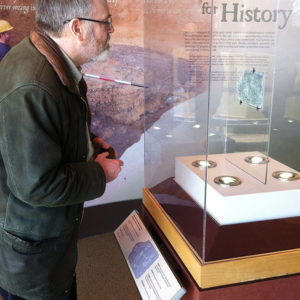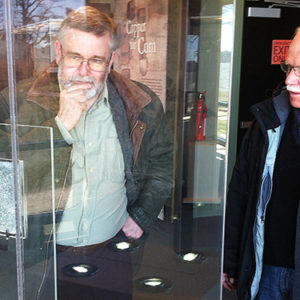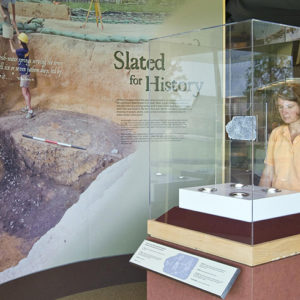An English expert on slates visited Historic Jamestowne in March to get a closer look at the tablet on display at the Archaearium.
“It’s truly impressive,” said Dr. Chris Caple, senior lecturer in the department of archaeology at Durham University in England. “It really is interesting to see these things face-to-face.”
He has been director of the postgraduate program for artifact conservation at Durham since 1988, and he visited Williamsburg to observe one of his students at work with Colonial Williamsburg conservators. He visited Jamestown Island on March 22 after giving a lecture at Colonial Williamsburg about symbols once used to turn away evil: “Artifacts and Averting Evil: the identification of apotropaic symbols of Nevern Castle.”
Caple examined the Jamestown slate while discussing it with Dr. William Kelso, director of archaeological research at the Jamestown Rediscovery Project, and Bly Straube, senior archaeological curator at the project. Caple noted the difference in studying medieval symbols in an English castle and the symbols on the slate discovered at James Fort. In the Jamestown slate he found no symbols that indicated hidden messages, spells, or good luck charms.
“In my work, I want to understand the lexicon of the signs so that I can understand why symbols are being used, what language is being used,” he said. Looking at the Jamestown slate, he said, “These symbols are much more understandable.”
Jamestown’s slate tablet was found in a ca.1608-1610 well, dug by order of Captain John Smith. The well had gone bad by 1610 and may have contributed to the rash of deaths during Jamestown’s infamous “starving time” winter of 1609-1610. (This is not the well shown in this month’s video; the well in the video was James Fort’s second well, ca. 1610-1611.)
It is possible the slate belonged to one of the colonists who died that winter. But it could also have belonged to one of the survivors of the Sea Venture shipwreck in Bermuda who reached Jamestown in May 1610. When the new governor, Lord De La Warr, arrived a few weeks later, he commanded the settlers to pull down derelict buildings and gather the accumulated garbage to throw all of the debris into any open hole in the fort. Unused wells made convenient trash pits.
Slate tablets were used aboard ships to temporarily record the daily wind conditions and the ship’s speed and direction. A slate tablet is a reusable writing surface when the marks are made by a slate pencil (the pencil leaves white marks that can usually be wiped off for the next set of marks — the proverbial “clean slate”).
There are layers upon layers of inscriptions on the slate found in the fort well. It could just be the build-up left by repeated use. Or someone may have written on the slate with something more dense than a slate pencil, making permanent scratches. Some markings are badly fragmented, others are almost complete.
The slate is a snapshot of English culture in the time of Shakespeare. The artwork includes sketches of three men, a woman, and heraldic drawings of fleur-de-lis on one side, and four lions, two men, three birds, and a tree on the other. There are two lined rows of printed text. The first line contains a series of letters with what could be the date “1598.” The second line states either “I AM NON OF THE FINEST SORTE” or “A MINON OF THE FINEST SORTE.” A “minon” or “minion” can be a servant or a type of cannon.
Looking at the drawing of a man with puffy Venetian breeches and a tight-fitting jacket called a doublet, Caple noticed that the legs had multiple vertical lines below the breeches. “We don’t know if the shapes mean much, but we do know that the space is filled,” he mused.
Caple asked how many artists may have worked on the slate, and Kelso said the markings appear to have been made by at least three different people. That led to a discussion of whether or not scientific techniques can show which marks were made first. Caple has made several studies of this question for his work in England.
“Unfortunately, I had difficulty figuring out which scratch was first and which was second. In a couple of cases, I could see it. But for many I couldn’t.”
Since his PhD work on medieval pins, Caple’s study of artifacts has ranged from Durham Cathedral doors to Anglo Saxon pendants and brooches. His work led him to write Objects: Reluctant Witnesses to the Past, a textbook to aid museum studies and archaeology students.
related images
- Applying chalk to the tablet to better see the etched images
- Dr. Chris Caple examines the Jamestown slate
- Dr. William Kelso discusses the slate with Dr. Caple
- Jamestown Rediscovery Archaeologist Jamie May reviews the slate display









